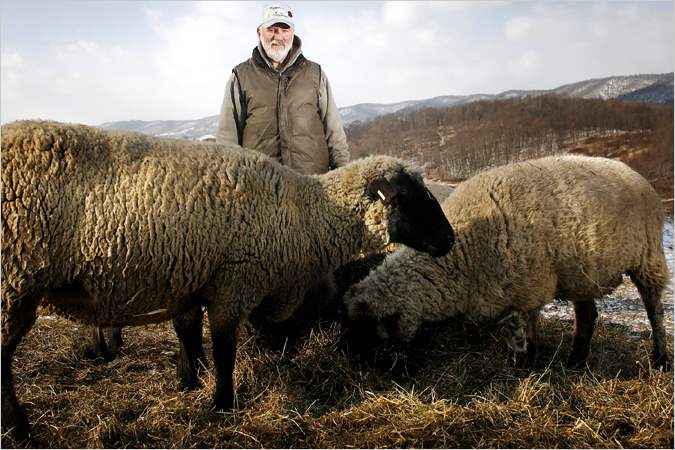In a Corner of Virginia’s ‘Switzerland,’ a Division Over a Planned Wind Farm
The New York Times
February 13, 2007
By PAMELA J. PODGER

MONTEREY, Va. — Wes Maupin says he will move this spring to a 20-acre spread here in remote Highland County, a pastoral place where sheep outnumber people and where little has changed since his boyhood, when he fished the county’s mountain streams with his father.
Mr. Maupin, a 52-year-old former corrections worker, does have one misgiving, though. Like many others in Highland, known for its rustic heights as Virginia’s Switzerland, he finds no joy in the prospect that these blustery Allegheny ridges could soon become home to the state’s first wind farm: 19 wind turbines, each taller than the Statue of Liberty, its pedestal included.
“Any wind farm,” Mr. Maupin said, “would surely change the character of this county forever.”
Much as disputes over the aesthetics, economics and environmental impact of wind farms have arisen in Vermont, Massachusetts, North Carolina and elsewhere, the proposed project here, first put forth eight years ago, has divided the 2,500 residents of Highland County, one of the least populated counties east of the Mississippi. Where some see unwelcome industrialization of the wilderness, others see green energy and an estimated $200,000 a year in tax revenue for the financially needy county.
Though the farm would sit on only 50 acres of the county’s 416 square miles, many fear it would be just the vanguard of similar local projects providing electricity for the regional grid.
“People around the state feel Highland should be sacrificed because not too many people live here,” said Sandy Bratton, 64, a fourth-generation landowner. “They view us as docile, uneducated people.”
But at Grady’s Barber Shop here in Monterey, the county seat, 35 miles west of Staunton, Roy Waggoner said he supported the $60 million project.
“One way to clean up the environment is with the wind turbines; it’s green energy,” said Mr. Waggoner, 57, a sheep rancher. “I don’t want to see them on every inch of land, but that ridge is very secluded.”
To be sure, the wind farm still faces hurdles. Though local officials have approved it, opponents have sued them in an effort to overturn their decision. Federal and state agencies oppose the project until sufficient bat, bird and other environmental studies are done. Further, a state hearing examiner is not expected to decide until March whether to recommend that the Virginia Corporation Commission issue a permit allowing the developer, Highland New Wind Development, to build and operate the turbines.
The man behind the project is Henry McBride, retired poultry farmer and founder of Highland New Wind. Mr. McBride intends to build the windmills on a part of his 4,000-acre ranch here not far from the West Virginia state line. He will sell electricity directly to a utility, a city, an energy cooperative or another power purchaser, said a family spokesman, Frank Maisano, a wind energy lobbyist in Washington. The project would generate 39 megawatts, enough for more than 15,000 homes, Mr. Maisano said.
Highland County has long worked to promote ecotourism; the number of lodgings that cater to birders, hikers and other visitors has tripled in the last decade. But since the wind farm was proposed, queries from people thinking of moving here have dropped to about 50 a year from 325, said Carolyn Pohowsky, executive director of the Highland County Chamber of Commerce.
“It has been a very controversial and polarizing issue,” Ms. Pohowsky said. “Because this is a new industry in the state of Virginia, we have no idea of what the outcome will be. You not only have the family farm at risk, and your livelihood at risk, but your heritage at risk.”
Jerry Rexrode, a county supervisor who voted to approve a conditional use permit for the wind farm in 2005, said most people he had talked to supported the project. David Jessee, manager of an auto parts store, said of the turbines: “I don’t see a thing wrong with them. Economically, the windmills would draw in a little money and maybe bring everyone up around here.”
But Randy Richardson, president of Highlanders for Responsible Development, a group that opposes the project, said people worried about noise pollution from the turbines’ blades and light pollution from the red strobes that would alert aircraft to the 400-foot-tall structures.
“We actually had some guy saying these will be similar to the windmills in Holland,” Mr. Richardson said. “Well, there is a little bit of difference between a quaint Dutch windmill and a 400-foot turbine.”
Tom Brody and Patti Reum own Bear Mountain Farm and Wilderness Retreat, a lodging and environmental center that attracts birders, stargazers and hikers. It is near the site of the proposed turbines.
If development proceeded, “we would have to leave,” Ms. Reum said. “If our business doesn’t make it, we can’t live here.”
Freelance Writing, Editing & Storytelling
Compelling and accurate narrative
Writing. Done. Right.